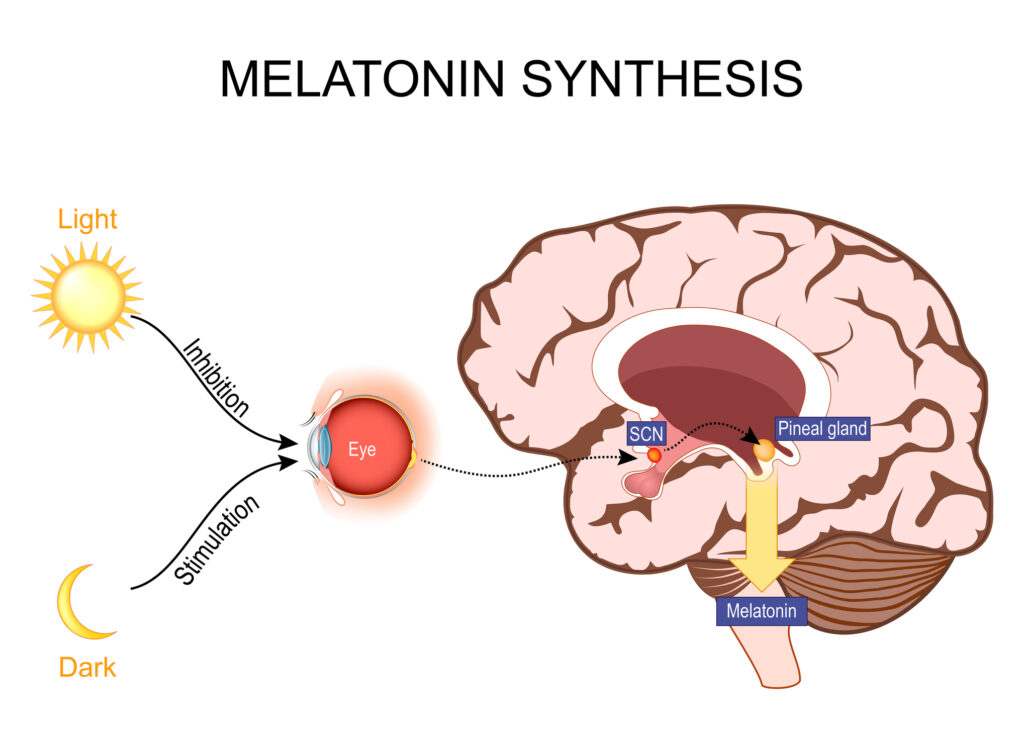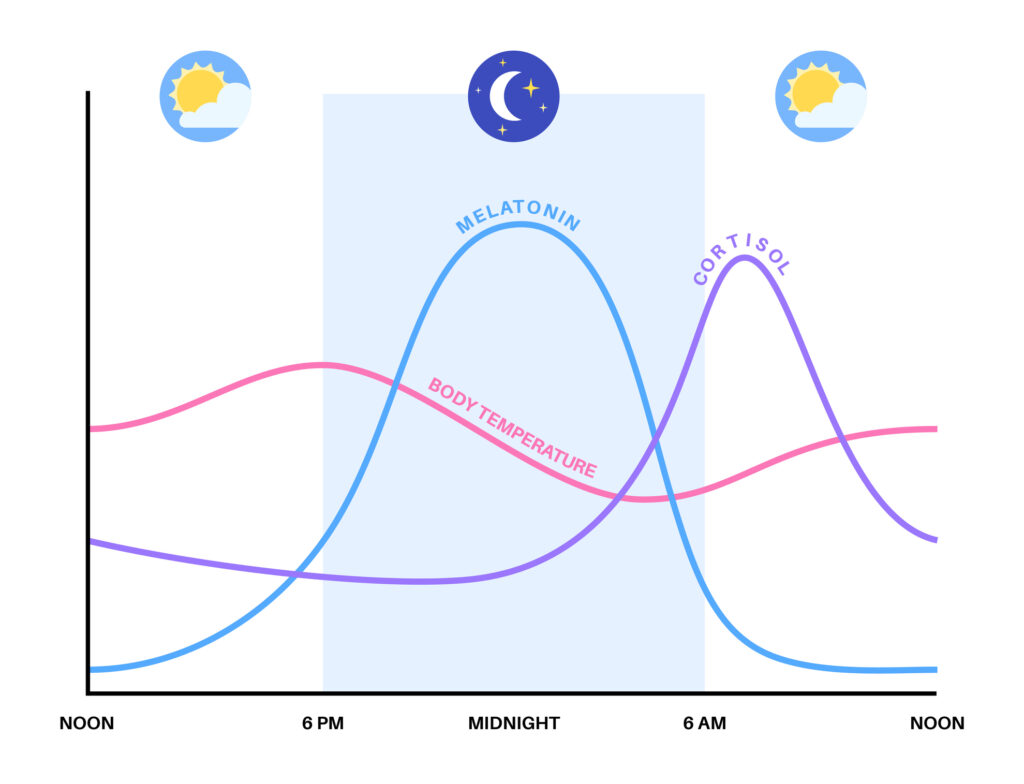When it comes to boosting our mental game, there is a secret weapon hiding in plain sight: Light. Yes, you read it correctly, good old-fashioned light. It’s not magic or voodoo science – it’s a simple and underestimated tool available to all of us.
We often take it for granted, but light isn’t just vital for the growth of plants and the ripening of fruits – it’s a crucial element for human beings’ functioning. In this article, we’ll zero in on the mental advantages of exposing oneself to light. I (Sanjin) will explain how light influences your brain and focus, and I’ll share protocols to leverage this influence in your everyday life.
Light: The master of your internal clocks
Your body is a finely tuned instrument, and one of the ways it maintains a sense of order is through circadian rhythms. These internal biological clocks regulate various physiological and behavioral processes over a roughly 24-hour cycle. Perhaps you’ve noticed how you naturally feel more awake and alert during the day and gradually become drowsier as evening approaches. That’s your circadian rhythm at work. These rhythms aren’t just some abstract concept but deeply rooted in biology. They dictate when you should eat, sleep, and even when your cognitive abilities peak. Light is the main regulator of our circadian rhythms.
The pivotal role of light in circadian rhythms is most visible when we change time zones. I’m sure you’ve already experienced jetlag. Your sleep-wake cycle is off, which is not fun at all, but here is the remarkable part: After spending a few days at the new location, your body adapts. Light makes that possible. Exposing yourselves to light during the new local daytime sends a clear message to your brain, effectively saying, ‘This is morning; this is evening.’ This visual cue helps your internal clock adapt to the new time zone by aligning your biological processes with the external environment. All your biological processes are reset to the new time zone, as is your focus.
Variations in focus throughout the day
Like all biological functions, focus follows a circadian rhythm. Research shows that, on average, focus is lowest at night and early in the morning. It improves after getting up (for most people between 10:00 a.m. to 2:00 p.m.), declines after lunch, and rises again in the afternoon and early evening (from 4:00 p.m. to 10:00 p.m.).

These daily variations in focus are not the same for everyone; we all know early birds and night owls. So it’s important to know your own rhythm when planning your day. But one thing is certain: a regular daily rhythm is essential to maximize your focus. One hormone in particular plays an important role in regulating this cycle: melatonin.
Melatonin: The sleep hormone
Light plays a pivotal role in regulating our sleep-wake cycles thanks to its action on melatonin production. Melatonin is a hormone produced by the pineal gland in response to signals from the suprachiasmatic nucleus (SCN). When morning light enters our eyes, it sends a message to the SCN, signaling that it’s daytime. The SCN reacts by inhibiting melatonin release from the pineal gland. As daylight wanes and evening approaches, the SCN recognizes the diminishing light cues. It interprets this as the onset of nighttime and signals the pineal gland to increase melatonin production and release.

Melatonin, often referred to as the “sleep hormone,” is crucial for inducing drowsiness and regulating our sleep patterns. By modulating melatonin levels in response to light and darkness, our body aligns our sleep-wake cycle with the natural day-night cycle. This intricate system ensures that we feel alert and awake during the day and sleepy at night, promoting a healthy and well-regulated circadian rhythm.
Do you want to know more about the influence of light on the human body? Check the video below. Among other things, you’ll learn how researchers have discovered how the internal clock of the blind adapts to light thanks to groundbreaking research on toad skin, yes, toad skin 🙂
Okay, but how does all this apply to you?
So, this is all fine and well, but perhaps it’s not quite clear how it all works. Well, let’s take an example of a regular day.
You had a good night’s sleep, and unfortunately, it is time to wake up and go to work. You’re snug in bed in your dark bedroom, and understandably, you’re having trouble waking up. Out of nowhere, the curtain opens, and sun rays come blazing in the room. Bright light enters your eyes, and your brain reacts immediately: Your pineal gland, the melatonin factory in your brain, goes into rapid shutdown mode, and melatonin levels drop almost immediately. The light entering your eyes triggers a signal to a brain region known as the locus coeruleus, causing a surge of adrenaline, making you awake and alert, similar to the effects of being dropped into cold water (check out the article on cold exposure). Your body temperature, heart rate, and blood pressure rise, and you get an early-morning cortisol release.

As the day goes on, assuming you are taking as much sunlight and artificial light as possible, you feel more alert and focused. However, as you finish work and go home, it gets dark: Low-angle late afternoon sunlight signals your brain that it is time to start preparing for sleep. Your pineal gland starts producing more melatonin. Finally, it’s bedtime. As you fall asleep, body temperature drops, and melatonin levels peak. Gradually, as you sleep, melatonin decreases, and when the sun’s rays break through the curtains in the morning, the process begins again with the start of a new day.
How to Leverage Light for Peak Focus and Energy
Now, let’s get practical– how can you put the benefits of light into action in your daily life? It’s surprisingly simple! Here’s what you need to do.
In the morning: Expose yourself to natural light
First and foremost, viewing sunlight within the first waking hours is excellent for getting to that wakeful and alert state. This simple ritual works wonders and sets the tone for the day: Your adrenaline, noradrenaline, and dopamine go up, your body temperature rises, your melatonin plummets and quickly you become alert and focused. Light also triggers the release of early-morning cortisol, which jumpstarts your alertness and focus and gives your immune system and metabolism a gentle nudge in the right direction.
Morning sunlight also plays a crucial role in fine-tuning your circadian rhythm. By exposing yourself to morning sunlight, you’re helping to calibrate this inner clock, ensuring a healthy sleep-wake cycle.
Morning light protocol
Spend 5-10 minutes outdoors in the morning sun, preferably right after you wake up. You can face the direction of the sun; just be sure not to stare directly at it (never stare directly at the sun!). If the weather is cloudy, you should prolong the time spent outside to 15-20 minutes. Use this time to sip your morning coffee, take a leisurely walk, read, or indulge in any activity you enjoy. If when you wake up, it is dark outside, turn on as much indoor light as possible.
In the afternoon: Enjoy the sun and sunset
Spending some time in the afternoon sun is also beneficial. Exposure to natural light during the day, such as taking a walk outside when you feel fatigued after lunch, can effectively rejuvenate and enhance focus by inhibiting melatonin release. Even if you missed the morning sunlight, catching some rays in the afternoon provides your brain with another “anchor point” to gauge the time of day and adjust your internal clock accordingly.
Then, when the sun is low in the sky during late afternoon, it emits wavelengths in the yellow and orange spectrum. These hues signal to your brain’s circadian clock to prepare for the evening and the eventual transition to sleep. So, whether it’s a sunny or cloudy afternoon, get a dose of sunlight when the sun hangs low on the horizon. Stick to the same time markers of 5-10 minutes or extend to 15-20 minutes if the day is overcast. This practice will prepare your brain for a restful night’s sleep and help your body establish a reference point in the daily cycle.
In the evening and night: Dim the lights
Looking at bright lights in the evening and at night hinders melatonin production and sleep. So, as bedtime approaches, start dimming the lights and turning off screens such as your phone or laptop.
If you often wake up in the middle of the night, avoid switching on bright lights so as to not disrupt your melatonin production. Use dim amber or red lights if you need to navigate around your home.
Pro Tip: For better sleep, make sure your room is as dark as possible and a bit cooler than usual. This will help you fall asleep and increase the quality of your sleep.
A few extra pointers
- Wearing eyeglasses or contacts is okay, but you should avoid sunglasses or blue blockers while viewing morning sunlight, as it will reduce the effects of the light.
- Light going through a window or your car’s windshield is not as efficient as being outside. Windows reflect many of the necessary wavelengths. So take the time to be outside: drink your coffee on the balcony, go for a walk, or take the bus one stop later.
- Use artificial overhead lights: In addition to natural sunlight, you can turn on bright overhead lights in the morning and mid-afternoon. This will help stimulate the release of molecules like dopamine, norepinephrine, and epinephrine – all associated with drive and motivation. It also encourages the optimal production of cortisol, enhancing your alertness and focus.
- Optimize your workspace: Position your work desk near a window to benefit from natural light. It brightens up your workspace and connects you with the outside world.
In Sum
Life is a series of cycles. Our bodies are finely tuned to these natural rhythms, and light plays a pivotal role in helping our brains and bodies align with the world outside.
Yet, this potent tool is often overlooked. Its potential is only beginning to surface in research and applications, but the beauty of it lies in its accessibility – light is free, and with minimal effort, you can harness its power to optimize your focus, boost your energy, and maintain a healthy sleep-wake cycle. So, as you step outside in the morning, breathe in the fresh air, and let the sunlight into your eyes, remember that you hold a remarkable key to enhancing your well-being right at your fingertips.
If you’re hungry for more insights into improving focus, explore our other posts on deliberate cold exposure for focus, the transformative impact of breathing on mental performance, and my personal journey of rediscovering focus after a life-altering health event. And if you want to dive even deeper into the topic of light, I leave you with some useful sources below:
- Huberman Lab
- Samer Hattar podcast
- Dr. Rhonda Patrick
- Circadian Rhythms in Attention (Yale Journal of Biology and Medicine)
- Skin Exposure to Ultraviolet B Rapidly Activates Systemic Neuroendocrine and Immunosuppressive Response (Photochemistry and Photobiology)
- Light exposure during sleep impairs cardiometabolic function (Proceedings of the National Academy of Sciences)
- Effects of light on human circadian rhythms, sleep and mood (Somnologie)
